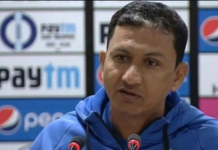India has a lucky number 13.
He lifts iron weighing up to 165kg in the gym. And covers as much as 8km on the pitch. He scores goals and intercepts passes. Launches booming aerial balls and plays defence-splitting crosses. A free man who, with impeccable vision, sets his teammates free.
There’s not a lot Harmanpreet Singh doesn’t do. Yet, on most days, it’s his misses that get talked about more. Invariably before every match and after it, the India captain gets asked about his ‘poor’ conversion rate from penalty corners. Each time, he smiles back: “Bilkul, koshish karte rahenge (Of course, I’ll keep trying).”
It’s a travesty that Harmanpreet’s contribution is reduced merely to his drag-flicks. The final group stage match of the Asian Champions Trophy against Pakistan, a 4-0 victory, was another reminder of all that he brings to the table.
On a night when Pakistan looked threatening in phases with their breezy counter-attacks and speedy turnovers, Harmanpreet’s vice-like grip ensured the story followed the script in front of a packed Mayor Radhakrishnan Stadium.
It very nearly went awry as Pakistan’s young bunch played with freedom and fearlessness that caught India off guard. Had they been a little more clinical in the attacking third – and not been on the receiving end of what their coach Muhammad Saqlain called ‘very poor’ umpiring calls – things could have been different.
But Harmanpreet’s two goals – powerful drag-flicks either side of the goalkeeper – put India on course to the facile win over Pakistan to set up a semifinal clash with Japan on Friday (the second semifinal will be between Malaysia and Korea).
But as is the case with Harmanpreet, it wasn’t just about the goals.
In a team of lively, extroverted characters, Harmanpreet is the quiet one. And while the team is split between Messi and Ronaldo fans, he brings both groups together and also throws Xavi in the mix. For, videos of these three players are said to be populating his hard drive.
On most days at the national camp in Bengaluru, he’ll be watching old videos, not of himself, but of these footballers and, at times, even basketball players.
If not sports, biopics are on his watchlist. “I try to learn a lot from the lives of other players,” he had told this paper in an earlier interview. Back then, he’d just finished watching The Redeem Team. “It was so good; you get to learn about their mentality, the way they think. It’s inspiring.”
He’s, more often than not, the last to leave the training ground too. After everyone’s gone, Harmanpreet will be alone on the pitch with the ball, figuring out new angles and imagining passes.
“I visualise alone. I take 3-4 balls and then create match situations. If I have to play a ball on the run, then what can I do? Or if I simply have to split the defence… That practice comes in handy sometimes during a match because I don’t waste an extra second thinking.”
Complete player
It’s a glimpse into the mind of a player who is mostly known for his brawn. Harmanpreet’s drag-flicks, which fly at speeds of up to 150kmph, are the stuff of legend – he is currently the top-scorer of the tournament – but his other subtle contributions with utmost nonchalance are equally breathtaking.
Like the moment in the second half against Pakistan on Wednesday. Harmanpreet won a free hit in a seemingly harmless position near the half-line. Even as the Pakistani players were getting into their positions, Harmanpreet spotted a gap in their defence and with lazy elegance, slapped the ball from the half-line into their ‘D’. Akashdeep Singh got a touch to it but not enough to deflect the ball into the goal.
It’s in defence, though, where Harmanpreet’s interventions are decisive.
Glenn McGrath says long layoff will help Jasprit Bumrah return fresh to international cricket
When Pakistan began sharply, entering India’s ‘D’ inside the first minute and scoring a goal, his decision to challenge the call led to the strike being overturned. When their attackers tried to get behind the defence, he remained a step ahead, read the moves and calmly intercepted their passes.
This was the trend even at the World Cup earlier this year, where he was panned for not converting the dozen or so penalty corners that came India’s way.
Harmanpreet plays as a free man, who is essentially a defensive problem-solver; a player who operates in the space between defence and midfield, stopping the ball from entering the circle.
“My responsibility is to block the hotline (the direct line between the attacker and the goal),” Harmanpreet said. “I have to communicate with the midfielders and forwards. If their man is in a particular position, I have to tell them to mind their man.”
Communicating with teammates, blocking passing channels, launching attacks, challenging the umpires’ calls and taking drag-flicks. If he is overburdened, Harmanpreet isn’t showing it.
“If you are casual on the field, then you get lazy; that spark is missing. Your mind is sharp, responsibility hai, communication hai; you are constantly analysing the game even when on the field,” he said. “I enjoy all these responsibilities.”
The responsibility will only increase as India mount a challenge to reclaim the Asian Games gold. And they’ll rely on their lucky number 13.
.













